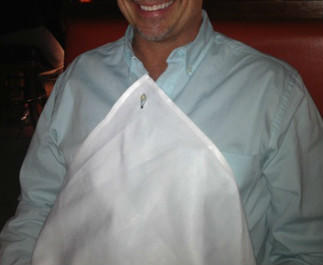There are some interesting details found on our clothing and some items we use, even today, that are remnants of our sartorial history. Even though a lot do not serve any real purpose or as much of a purpose as they once did by today's fashion standards, they remain with us.
Buttons on different sides of the shirt for men vs. women

On a majority of button down shirts, men's buttons are placed on the right and women's on the left half of the shirt. From a historical perspective, since most men are right handed, when a man was on the hunt or in battle, he would pull his weapon from his left side using his right hand. For the sake of practicality, buttoning his clothes from right to left would have impeded his movement and been more difficult to do in a time crunch. It was faster and quicker for him to have the buttons placed on the right. If you've ever looked at old paintings such as this one of Napoleon, you'll notice a lot of hands leisurely tucked into the waistcoat from right to left. A weapon would typically be resting or fastened to the body on the left hip so they could draw down using their right hand to grab the weapon easily on the left hip.

For women there are actually several explanations. One explanation is that women's clothing, for the wealthy that is, required that a maid dress you. If your hand maiden was facing you while trying to dress you, it would be easier for her to button the buttons if she could grasp the button into her right hand, and close with the left.
Another explanation is that when women had babies, they would typically hold the baby in their left arm, or non dominant arm. When they went to breastfeed their baby, it would be much easier to simply pull the buttons apart when fastened with the free right hand, which was and is usually their dominant hand.
And yet another more puritanical theory was that clothing manufactures and society at large wanted to make it clear that a man is a man, and a woman is a woman, and what better way to make that especially clear than to really differentiate between what is considered to be women's clothing and what is considered to be men's. If you picked something up with buttons, the detail would automatically give that away because the buttons would be on a particular side.
The difference between men and women's bikes

Men's and women's bikes differ due to the fact that when the bike was first invented, women weren't wearing pants, at least not in the mainstream. They wore long skirts that touched the floor. When it came to bike riding, the skirts would get trapped and cause the rider to fall, so the middle bar was dropped low to accommodate the long skirts. Also the handle bars are often lower than a man's bike and the seat built slightly differently.
The Button Hole Napkin

When shirts with lace fronts first came into vogue in the 18th century, napkins were tucked into the neck or buttonhole or were attached with a pin. I've actually only ever seen this type of napkin in two restaurants in my whole life, but if you've seen it, just as in the past, the napkin is there so that male diners may attach the button hole around their top button so as to protect the clothing with the napkin, from food spillage. I say males, because typically a lot of women's clothing is not button down so it would generally not serve a purpose for women.

The Fifth Pocket

Before World War I, men wore pocket watches which were watches that a man could slip in and out of his pocket via a chain attached to himself to check the time. In 1873, Levi's created the jean with the fifth pocket to allow cowboys to be able to secure their pocket watches on rides. It just wouldn't have been practical to have the watch around the neck or to slip free from the pocket or the chain and thus the pocket was invented. The actual watch as we know it today came about also for practical and safety reasons during WWI because soldiers did not want to have to constantly search or look down for a length of time to try and find the time so a watch with a strap was invented. In regards to the fifth pocket in modern times, in some cases the size of the small pocket has shrunk, but the small pocket has never really went away. Most in modern times use it to store condoms, coins, matches, lipstick, or other trinkets.
The loop on back of a man's shirt

Back in ye olden days homes and dwellings did not really have closets as we know them today, so a man would have to hang his shirt up on a hook using the loop. Also because there were no dryers, clothes were line dried, and this made them easy to hang on the line. Somewhere around the 50's, it is said that a boy who had decided to go steady with his girl would snip the loop off the back of his shirt, and his gal would wear his letterman jacket to let everyone know they were an item.
Most Helpful Opinions